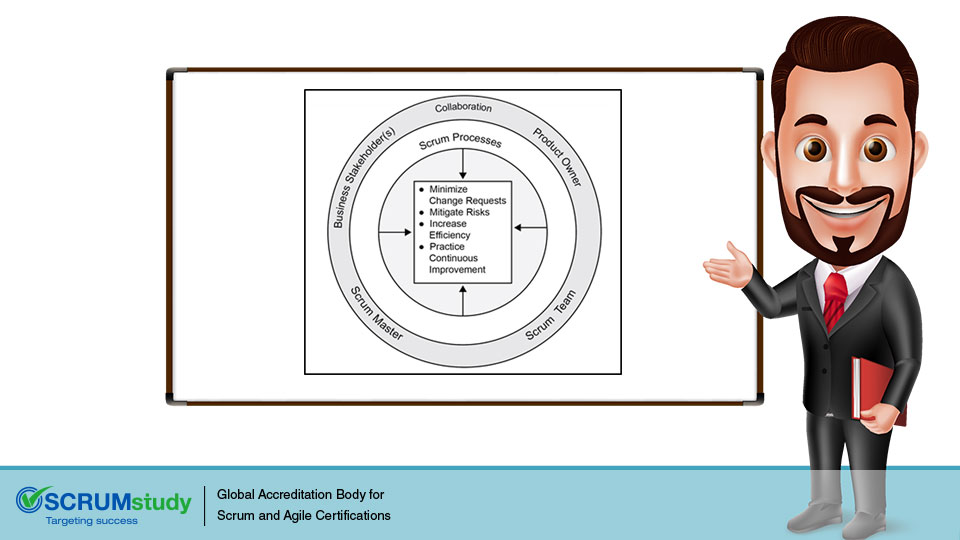How does customer collaboration weigh over contract negotiation?
Posted bySCRUMstudy® on October 13, 2022
Categories Agile Product Backlog Product Development Project Delivery Scrum Scrum Guide Sprint Backlog
How does customer collaboration weigh over contract negotiation?
Collaboration in Scrum refers to the Scrum Core Team working together and interfacing with the business stakeholders to create and validate the deliverables of the project to meet the goals outlined in the Project Vision. It is important to note the difference between cooperation and collaboration here.
Cooperation occurs when the work product consists of the sum of the work efforts of various people on a team. Collaboration occurs when a team works together to play off each other’s inputs to produce something greater..
The core dimensions of collaborative work are as follows:
- Awareness—Individuals working together need to be aware of each other’s work.
- Articulation—Collaborating individuals must partition work into units, divide the units among team members, and then after the work is done, reintegrate it.
- Appropriation—Adapting technology to one’s own situation; the technology may be used in a manner completely different than expected by the designers.
Benefits of Collaboration in Scrum Projects
The Agile Manifesto (Fowler & Highsmith, 2001) stresses “customer collaboration over contract negotiation.” Thus, the Scrum framework adopts an approach in which the Scrum Core Team members (Product Owner, Scrum Master, and Scrum Team), collaborate with each other and the business stakeholders to create the deliverables that provide greatest possible value to the customer. This collaboration occurs throughout the project.
Collaboration ensures that the following project benefits are realized:
1. The need for changes due to poorly clarified requirements is minimized. For example, during the Create Project Vision, Develop Epic(s), and Create Prioritized Product Backlog processes, the Product Owner collaborates with business stakeholders to create the Project Vision, Epic(s), and Prioritized Product Backlog, respectively. This will ensure that there is clarity among Scrum Core Team members on the work that is required to complete the project. The Scrum Team collaborates continuously with the Product Owner and business stakeholders through a transparent Prioritized Product Backlog to create the project deliverables. The processes Conduct Daily Standup, Refine Prioritized Product Backlog, and Retrospect Sprint provide scope to the Scrum Core Team members to discuss what has been done and collaborate on what needs to be done. Thus, the number of Change Requests from the customer and rework is minimized.
2. Risks are identified and dealt with efficiently. For example, risks to the project are identified and assessed in the Develop Epic(s), Create Deliverables, and Conduct Daily Standup processes by the Scrum Core Team members. The Scrum meeting tools such as the Daily Standup Meeting, Sprint Planning Meeting, Prioritized Product Backlog Review Meeting, and so on provide opportunities to the team to not only identify and assess risks, but also to efficiently implement risk responses (such as risk mitigation) to high-priority risks.
3. True potential of the team is realized. For example, the Conduct Daily Standup process provides an opportunity for the Scrum Team to collaborate and understand the strengths and weaknesses of its members. If a team member has missed a task deadline, the Scrum Team members align themselves collaboratively to complete the task and meet the targets agreed to for completing the Sprint.
4. Continuous improvement is ensured through lessons learned. For example, the Scrum Team uses the Retrospect Sprint process to identify what went well and what did not go well in the previous Sprint. This provides an opportunity to the Scrum Master to work with the team to rework and improve the team for the next scheduled Sprint. This will also ensure that collaboration is even more effective in the next Sprint.
Importance of Colocation in Collaboration
For many of the Scrum practices, high-bandwidth communication is required. To enable this, it is preferred that team members are colocated. Colocation allows both formal and informal interaction between team members. This provides the advantage of having team members always at hand for coordination, problem-solving, and learning. Some of the benefits of colocation are the following:
- Questions get answered quickly.
- Problems are fixed on the spot.
- Less friction occurs between interactions.
- Trust is gained and awarded much more quickly.
Collaboration tools that can be used for colocated or distributed teams are as follows:
1. Colocated Teams (i.e., teams working in the same office)—In Scrum, it is preferable to have colocated teams. If colocated, preferred modes of communication include face-to-face interactions, Decision Rooms or War Rooms, Scrumboards, wall displays, shared tables, and so on.
2. Distributed Teams (i.e., teams working in different physical locations)—Although colocated teams are preferred, at times the Scrum Team may be distributed due to outsourcing, offshoring, different physical locations, work-from-home options, etc. Some tools that could be used for effective collaboration with distributed teams include video conferencing, instant messaging, chats, social media, shared screens, and software tools which simulate the functionality of Scrumboards, wall displays, and so on.

